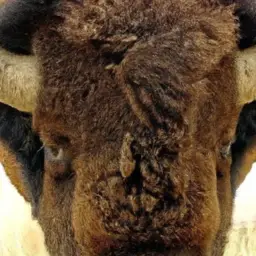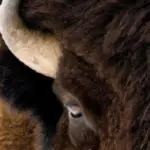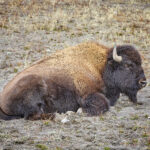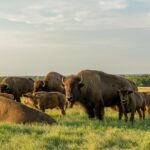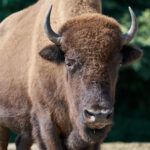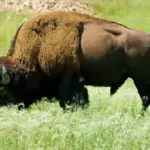Have you ever wondered how much a bison weighs? Look no further than the “How Much Does A Bison Weigh” product. This handy tool provides you with all the information you need about the weight of these magnificent creatures. Whether you are a nature enthusiast, a wildlife researcher, or simply someone who enjoys fun animal facts, this product is sure to captivate your interest. Say goodbye to your curiosity and start exploring the fascinating world of bison weights today!
Overview of Bison Species
Different types of bison
Bison, or more commonly known as American buffalo, belong to the Bovidae family and are native to North America. There are two main species of bison: the American bison (Bison bison) and the European bison (Bison bonasus). Both species have slightly different physical characteristics and can be further categorized into different subspecies. The American bison has two recognized subspecies: the plains bison and the wood bison. On the other hand, the European bison has two subspecies: the lowland bison and the mountain bison.
Distribution and habitat of bison
Historically, bison roamed across vast areas of North America and Europe. However, due to human activities and habitat fragmentation, their populations have significantly declined. Currently, the American bison is primarily found in national parks and protected areas of the United States and Canada, while the European bison is found in forests and conservation areas in Eastern Europe. Both species require large grasslands or open woodlands for grazing and have adapted to various ecosystems ranging from prairies to mountainous regions.
Typical Physical Attributes of Bison
Size and stature
Bison are known for their massive size and robust build. On average, adult bison stand about 6 feet tall at the shoulder, with their body length reaching up to 10-12 feet. These formidable creatures can weigh anywhere between 900 to 2,000 pounds, depending on various factors such as age, sex, and overall health. Their sheer size and muscular structure make them one of the largest land mammals in North America.
Physical characteristics
Bison have several distinct physical features that help them thrive in their natural environments. They possess a large head with short, curved horns, a hump over their shoulders, and a thick coat of fur that allows them to withstand harsh weather conditions. Their fur is typically dark brown, but it can appear lighter during the summer months due to shedding and exposure to sunlight. Additionally, bison have a long, tufted tail that aids in swatting away flies and other pesky insects.
Differences between male and female bison
Male and female bison, commonly referred to as bulls and cows, respectively, exhibit subtle differences in their physical attributes. Bulls tend to be larger and heavier than cows, with fully mature bulls weighing up to 2,000 pounds, while cows typically range between 900 and 1,200 pounds. Bulls also have a more prominent hump and a thicker, muscular neck compared to cows. Moreover, bulls possess larger and more robust horns that curve upward, while the horns of cows are generally shorter and curve slightly outward.
Average Weight of a Bison
Weight range of a mature bison
The weight of a mature bison can vary depending on several factors such as its sex, subspecies, and overall health. On average, an adult male bison can weigh between 1,700 and 2,000 pounds, with some exceptionally large individuals reaching weights of up to 2,500 pounds. Adult female bison, on the other hand, weigh between 900 and 1,200 pounds. It is important to note that these weight ranges are approximate and can differ among individuals within a population.
Factors affecting a bison’s weight
Several factors contribute to the weight variation observed among bison populations. One significant factor is the availability and quality of their food sources. A well-nourished bison that has access to abundant grasses, herbs, and shrubs is more likely to reach its optimal weight compared to a bison living in an area with limited food resources. Additionally, factors such as age, genetics, and environmental conditions also play a role in determining an individual bison’s weight.
Comparing Bison Weight with Other Animals
Comparative analysis of weight between bison and cattle
When comparing the weight of bison to commonly domesticated animals like cattle, bison tend to have a greater average weight. Adult bison can weigh between 900 and 2,000 pounds, whereas adult cattle typically range from 1,000 to 1,800 pounds, depending on the breed. This disparity in weight can be attributed to the different genetic backgrounds, environmental influences, and dietary preferences of these two species.
Comparison of weight between bison and other large mammals
In the realm of large mammals, bison fall among the heaviest. They are surpassed in weight only by a few other species such as elephants and hippos. Elephants, the largest land mammals, can weigh anywhere between 6,000 and 14,000 pounds, depending on the species. Hippos, though not as heavy as elephants, can still reach weights of around 3,000 to 4,000 pounds. Thus, while bison may not be the heaviest creatures on earth, they certainly hold their own in the weight department.
Weight Differences in Male and Female Bison
Typical weight of a male bison
Fully mature male bison, known as bulls, generally weigh between 1,700 and 2,000 pounds. However, exceptional individuals have been recorded to weigh as much as 2,500 pounds. The weight of male bison is influenced by factors such as genetics, access to food resources, and overall health. A well-nourished and healthy bull will typically reach higher weight ranges compared to those with limited resources or underlying health issues.
Typical weight of a female bison
Female bison, commonly referred to as cows, are generally smaller and lighter than their male counterparts. Adult cows typically range in weight from 900 to 1,200 pounds. Similarly to bulls, the weight of female bison can vary depending on various factors, including genetics, diet, and overall health. Cows that have access to ample food resources and maintain good health will generally fall within the higher end of the weight range.
Weight Variation in Bison Due to Age
How the weight of a bison changes from calf to maturity
Bison experience significant weight changes as they progress from calfhood to adulthood. Calves are born weighing around 30 to 70 pounds and gradually gain weight as they nurse from their mothers and transition to eating vegetation. By the time they reach one year of age, calves usually weigh around 400 to 600 pounds. As they continue to mature, bison experience growth spurts, and their weight increases at a slower pace. By the time they reach full maturity at around four to five years of age, their weight can range from 900 to 2,000 pounds, depending on their sex and genetic factors.
Typical weight of a bison calf
Bison calves are relatively lightweight at birth, weighing between 30 and 70 pounds. They rely on their mother’s milk for nutrition during the first few months of their lives, and as a result, they experience rapid growth. By the time they reach six months of age, calves typically weigh around 300 to 400 pounds. It’s fascinating to witness the transformation of these small and fragile creatures into the majestic and robust bison they will become.
Typical weight of a mature bison
A fully mature bison, whether male or female, can reach impressive weights. On average, adult male bison weigh between 1,700 and 2,000 pounds, with outliers occasionally exceeding 2,500 pounds. Adult female bison, or cows, generally weigh between 900 and 1,200 pounds. The weight of a mature bison reflects the culmination of their growth and development over several years, shaped by factors such as genetics, diet, and overall health.
Importance of Weight in Bison Herd Structure
Impact of weight on social hierarchy
Within a bison herd, weight plays a crucial role in establishing a social hierarchy known as the dominance hierarchy. The larger and heavier individuals, particularly bulls, often assume positions of higher status, asserting dominance over smaller and lighter herd members. This hierarchical structure helps maintain order and reduces conflict within the herd, ensuring the efficient utilization of available resources and contributing to the herd’s overall stability.
Role of weight in mating and reproduction
Weight also plays a significant role in the breeding dynamics of bison. During the mating season, known as the rut, bulls engage in fierce competitions to establish dominance and acquire access to receptive females. Their large size and weight give dominant bulls a competitive advantage, as they are more likely to successfully defend their mating opportunities against rival males. They engage in displays of strength and aggression, such as butting heads and bellowing, to establish their dominance and secure potential mating partners.
How Diet Affects Bison Weight
Typical diet of a bison
Bison are herbivores with a primarily plant-based diet. They are well adapted to grazing on various grasses, sedges, and forbs, which constitute the bulk of their diet. Additionally, bison may also consume leaves, bark, and twigs from certain trees and shrubs, particularly during seasons when grasses may be scarce. Their diet is high in fibrous vegetation, and they have evolved a specialized digestive system that allows them to efficiently extract nutrients from coarse plant material.
How dietary nutrient ratios affect bison weight
The nutrient composition of a bison’s diet can significantly impact its weight and overall health. A balanced diet rich in protein, carbohydrates, and essential vitamins and minerals promotes optimal growth and weight gain. Adequate protein is especially crucial for healthy muscle development, which directly affects an individual bison’s weight. Access to high-quality forage and diverse plant species allows bison to obtain the necessary nutrients and contribute to their overall weight and well-being.
Impact of seasonal changes on bison diet and weight
Seasonal changes in vegetation availability and quality can influence bison’s dietary intake and subsequent weight fluctuations. During the warmer months, bison have a wide range of grasses and plant species to graze on, providing them with an abundance of nutrients. This period allows them to gain weight and store energy reserves for the upcoming winter. In contrast, during the winter months, the scarcity of food resources, especially in areas with heavy snowfall, can result in weight loss as bison rely on fat reserves to sustain themselves until spring when fresh vegetation becomes available again.
Bison Weight in Relation to Health and Longevity
How body condition and weight correlate with health
The weight and overall body condition of a bison are indicative of its health and well-being. A bison that maintains an optimal weight, along with good muscle tone and body fat reserves, is more likely to exhibit robust physical health. Adequate weight provides individuals with energy reserves to withstand harsh environmental conditions, fight off diseases, and successfully reproduce. A bison’s ability to maintain an ideal weight reflects its access to suitable food resources and its ability to compete for adequate nutrition within its habitat.
Ailments common in overweight bison
While maintaining a healthy weight is crucial, excessive weight gain in bison can lead to various health issues. Overweight bison may experience joint and musculoskeletal problems, making them more prone to injuries and impairing their mobility. Additionally, obesity can lead to metabolic disorders and reduced fertility, impacting their reproductive success. It is vital for bison populations to maintain a balance between proper nutrition and maintaining a healthy weight to minimize the occurrence of these health problems.
Average lifespan of well-nourished versus undernourished bison
The lifespan of a bison can be influenced by its nutritional status and access to abundant food resources. Well-nourished bison that can maintain an optimal weight and overall body condition are more likely to live longer and lead healthier lives. On average, bison can live up to 20 to 25 years in the wild. However, undernourished individuals that struggle to maintain a healthy weight may experience compromised immune systems and decreased resistance to diseases. This can significantly impact their longevity, resulting in a shorter lifespan compared to well-nourished counterparts.
What is the Average Size and Weight of a Bison?
The average size and weight of a bison can differ between males and females. On average, a male bison can weigh around 2,000 pounds and stand up to 6 feet tall at the shoulder. In size comparison between bison and human, these majestic creatures are significantly larger and heavier than the average person.
Methods Used to Determine the Weight of a Bison
Traditional manual measurement techniques
Traditionally, determining the weight of a bison involved employing various manual measurement techniques. These methods often required sedating or immobilizing the bison to ensure accurate weight measurements. One common approach involved using a pulley system to lift the animal and measure the pulling force required. Additionally, specialized scales and platforms were used to weigh individual bison, requiring careful positioning and training of the animals to ensure safety and accuracy during the weighing process.
Modern technology used in weighing bison
Advancements in technology have provided more convenient and efficient methods for weighing bison. Portable livestock scales equipped with load cells and digital displays are now commonly used in the field. These scales can be set up on-site and provide accurate weight measurements without the need for sedation or immobilization. Remote sensing methods, such as drones equipped with specialized cameras and software, can also be used to estimate the weight of a herd by analyzing their size and density.
Challenges involved in weighing a bison
Weighing bison can pose several challenges due to their large size, unpredictable behavior, and the need for accurate measurements. Safety considerations for both human handlers and the bison themselves are paramount. Bison are powerful animals, and any handling or weighing procedures must be carefully planned and executed to prevent injuries to both humans and animals. Additionally, the natural behavior of bison, including their resistance to confinement or manipulation, can complicate the weighing process. These challenges make it critical to utilize suitable equipment and employ trained personnel to ensure successful and safe weight measurement procedures.
In conclusion, bison are magnificent creatures who have captivated people with their incredible size and strength for centuries. Their weight varies significantly depending on factors such as age, sex, diet, and habitat conditions. From their role in the social hierarchy within herds to their impact on reproductive success, weight plays a crucial role in the life of a bison. Understanding and appreciating the significance of weight in relation to health, longevity, and overall well-being enhances our knowledge and admiration for these iconic North American animals.

